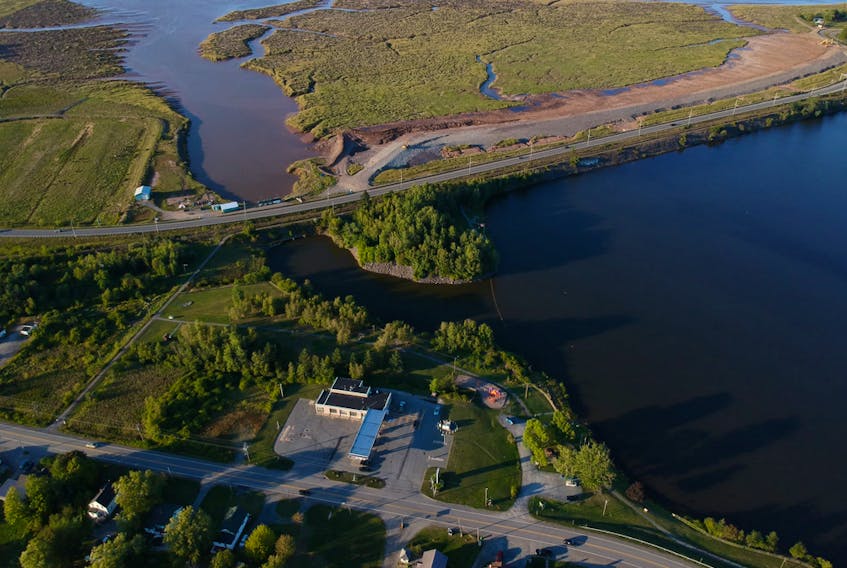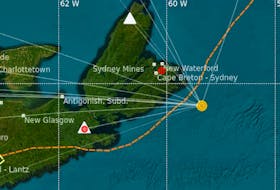WINDSOR, N.S. — There is no shortage of opinions on how the Avon River causeway and the twinning of Highway 101 between Windsor and Falmouth should be handled.
Online forums light up whenever the topic is raised.
Some argue removing the causeway and allowing the river to return to its natural state is the only viable, long-term solution.
Others argue Lake Pisiquid, the man-made freshwater lake, must be preserved as it serves as a recreational hub for Windsor. Others, further upstream, are concerned with their livelihoods and what impact increased salinity in the water has on crops and livestock.
It is pitting neighbour against neighbour as stakeholders weigh in on how the government should address the situation.
West Hants Mayor Abraham Zebian even urged residents to keep their cool during his monthly report at council on Sept. 22.
“There are so many points of view and so many affected by this project. It has become very divisive for some and I ask our residents to be calm and respectful of others and their opinions,” Zebian said.
As divisive as the issue is, everyone seems to agree on one thing: providing safe fish passage is a must. It’s just how do you do that?


Free tidal flow
The similarities between the Avon River and Petitcodiac River are striking.
Both are part of the Inner Bay of Fundy, with the Petitcodiac River located in the Chignecto Bay in southeastern New Brunswick and the Avon River located in the Minas Basin in Nova Scotia. Both are macrotidal estuaries, sharing tidal variations of more than six metres occurring twice daily, and have similar sediment loads. Additionally, they are frequented by a large number of migratory fish and marine animals — including the at-risk Atlantic Salmon.
Both areas were modified in the 1960s; both involved the building of causeways and creating head-ponds. Both have been deemed controversial; both have been called an ecological disaster.
In 1962, the federal Maritime Marshland Reclamation Agency proposed the causeway for the Petitcodiac area as a better option than rebuilding the dike system in the upper reaches of the Petitcodiac and installing a bridge. The causeway opened in 1968 and almost immediately, the ecological effects of the decision were noticeable.
During this same time frame, the Nova Scotia government was considering a causeway for the Avon River as part of the development of Highway 101. The causeway, which opened in 1970, resulted in the Avon River being obstructed by a rock and earth filled causeway and the creation of Lake Pisiquid, a freshwater, man-made head-pond that is used primarily for canoeing and recreational purposes. The causeway controls the discharge and incoming tidal waters through a series of flood gates.
Following considerable lobbying, in August 2007, the New Brunswick government announced it would remove the causeway blocking the Petitcodiac River. Phase 1 got underway with dikes being rebuilt and other preparatory measures taken. This was previous to opening the gates. In 2010, the causeway was removed. Phase 3, which involves the installation of a bridge, is predicted to wrap up in 2021.
This timelapse of satellite images of the Petitcodiac causeway shows how 2010 changed the river. - Google Earth
Daniel LeBlanc, a former Petitcodiac Riverkeeper (and the first Canadian to hold a Riverkeeper title) is the current administrator of Sentinelle de la Côte Acadienne. He’s been aware of Windsor’s causeway issue for more than 20 years.
LeBlanc was contacted in 2019 by the Friends of the Avon River to look into the situation in Nova Scotia and provide feedback.

Retired Department of Fisheries and Oceans habitat manager Denis Haché, a professional engineer with 30 years of work experience with DFO in Atlantic Canada — 10 of which was in Petitcodiac, helped LeBlanc’s organization review the Avon River aboiteau project.
In January, a letter was sent to Bernadette Jordan, the federal minister of Fisheries and Oceans. The letter states the final option, unveiled in late November 2019, for moving forward with the Avon River causeway would not achieve acceptable fish passage at this structure. Free tidal flow is not being considered.
Further, the group questions the costing quoted for repairing the 15 kilometres of dikes and aboiteau located upstream. The government states it would cost $50 million (about $3.33 million per kilometre), while in Petitcodiac, the construction of dikes and aboiteau above the causeway bridge cost $6 million for 23 kilometres in 2008 — approximately $250,000 per kilometre.
“We believe that the treatment of the Avon River should be similar to what was done in New Brunswick. Essentially, it’s the same Bay of Fundy, it’s just in two different provincial jurisdictions,” said LeBlanc in a phone interview.
“We all have to be subjected to the same national laws, whether it’s fisheries or consultation with First Nations, who are the right holders of fisheries.”

Earlier this month, LeBlanc presented his case to West Hants council, urging support of free tidal flow.
LeBlanc said the Petitcodiac region has been revitalized by the removal of the causeway.
“The benefits have been very noticeable and quite widespread throughout the watershed,” said LeBlanc, noting the strong tidal bore has returned, which has turned into quite a tourist attraction.
“The fisheries (return) was dramatic and almost overnight.”
They experienced less flooding issues in Moncton as the head-pond worked against the natural drainage of the ecosystem.
LeBlanc said the image of the region improved “because for many years, it was a known mark on the region that it had this awful situation with the river dying.”
If Windsor follows suit, they could experience similar benefits, he said.
Indigenous concerns
A group of concerned citizens has been protesting outside the causeway gatehouse property this year, some sleeping in tents as they stay the course to raise awareness of the limited fish passage currently available.
Multiple Mi'kmaw communities and environmental groups are involved, all opposed to the Highway 101 twinning project that would see the causeway widened and the construction of a controlled tidal exchange installed.
In August, Sipekne'katik First Nation in Nova Scotia requested the Province of Nova Scotia to temporarily halt construction near the Avon River.


Keeping saltwater at bay
There is definitely opposition to reopening the river in Windsor. Numerous letters have been received by West Hants council, some from farmers, some from recreational users, some from businesspeople.
Chief among the concerns is what will happen to farms and businesses that rely on the existing freshwater.
At the Sept. 22 council meeting, a presentation was made by Alyson Bremner and Nicholas Juurlink, of Linked Farms Ltd. in Falmouth. The couple spoke about the importance of protecting food production, and also submitted a letter outlining their concerns.
Linked Farms is a producer of beef, custom-raised dairy heifers, free-range chickens, some field crops, and ever‐bearing strawberries.
Bremner, who is an eighth-generation farmer, says they were surprised to discover the increase in salinity in the water this summer.
“As we found out this year, different plants have different tolerances to salinity in irrigation water. Most fruit crops are very sensitive, followed by vegetable, field and forage crops,” said Bremner at the meeting.
The couple described the planting process for their strawberries and how they continually monitor them to ensure they receive the nutrients required to produce top quality fruit. They employ a professional entomologist to regularly inspect the fields to detect disease or insect pressures.
“Because we use less than 23,500 litres of water per day, we don’t need a water use permit through the Department of Environment. We were using the river to water these strawberries,” said Juurlink.
They said the crop was coming along beautifully until August. Then the plants began showing signs of stress.
One of the first tests they conducted was for water quality. The water they were using had higher than normal salinity levels, which they say is because the causeway gates have been left opened longer per tide this summer.

“That kind of threw a little alarm to us because our main source of income on the farm, currently, is our beef, our livestock,” Bremner said.
When the cattle are in the barn, they don’t consume water from the river. However, when they’re out to pasture, they rely on the freshwater supply.
“We do have an environmental farm plan and controlled access area in which we water our livestock from the river when they are on certain pasture. This is why we got pretty concerned when our levels were over 1500 ppm,” said Bremner.
“Water of good quality is an essential component of successful livestock production. Poor water quality can result in economic loss to the producer and obviously an inferior product to the consumer. We really can’t afford to have an inferior product.”
They’re concerned with what happens if farmers in the area lose that source of freshwater.
“Freshwater equals food security,” said Juurlink.
Bremner said the take home message from 2020 was many Nova Scotian farmers struggled this year to source enough water for irrigation. They’re concerned what impact allowing longer gate openings — and potentially removing the causeway altogether — will have on area farmers.
Dean Manning, another Falmouth farmer, also presented to council Sept. 22 and he also warned of the increasing salinity levels and what impact that would have on crops and livestock.
During his presentation, he indicated several of the existing aboiteaus and dikes that used to protect the farmland along Falmouth and Windsor Forks are no longer operational.

When it comes to opposition to change, LeBlanc said the Petitcodiac River restoration project also encountered those who wanted to maintain the status quo. But, he said, the opposition quieted down once they realized the overall benefits of allowing free tidal flow.
“I think the community will have to accept that the only long-term solution that will work is the restoration of natural flow,” said LeBlanc of the situation in Hants County.
He said the sooner the community accepts that, they can begin identifying the issues that need to be addressed — like repairing and installing dikes and aboiteaus.
LeBlanc said the experience in the Petitcodiac River showed “restoration is less than leaving the situation with a Band-Aid and having to come back in five or 10 years to address it. The sooner it is resolved, the better it is for all the stakeholders but also the economy of the region.”
Timelapse imagery of the Avon River causeway area - Google Earth
RELATED LINKS
- Nova Scotia has duty to consult on Avon River Causeway: First Nation
- Avon River causeway opened to allow fish passage
- West Hants council seeking info as questions abound around fate of Avon River causeway
- DOUG POPE: Building second causeway will perpetuate environmental disaster
- First striped bass caught above Windsor causeway in decades
- ‘Competing interests’ remain as Windsor causeway solution undecided









